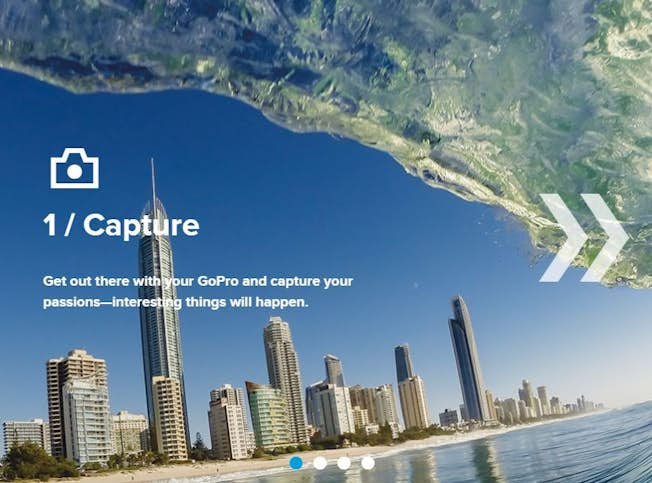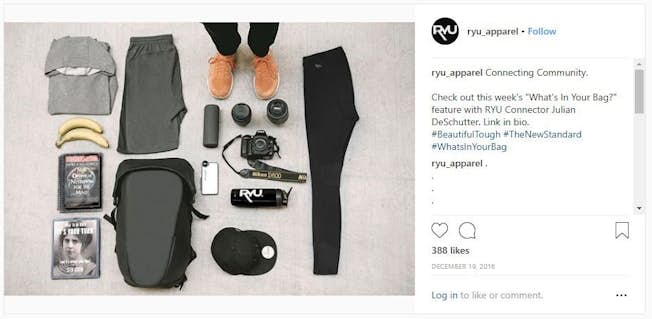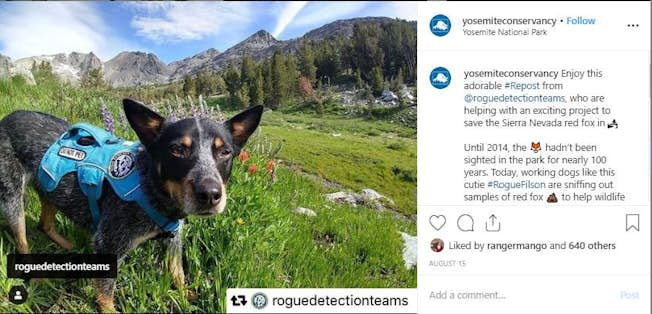Sep 9, 2019
4 Great Examples of User-Generated Content (UGC)
“85% of users surveyed were found to be more influenced by the UGC than the content made by the brands directly ” Adweek
The truth is, customers trust each other more than they trust brands. That’s why user-generated content (UGC) has gained such massive appeal among marketers and business owners.
User-generated content transforms loyal customers into enthusiastic brand campaigners to help build community engagement around services or products.
How to Begin a UGC Campaign
There are four steps to a top-notch user-generated content campaign:
- Design your concept and ‘main’ question: This question will be the focus of your campaign. Ask a question that evokes emotion, is specific and surrounds a theme you know your audience loves. Look at humanitarian organization Women for Women, who begin their UGC campaign by asking their audience to share a story about someone who inspires them.
- Launch and amplify: Launch the campaign by asking your community the question (from point 1), then engage with them. Amplify the best answers by posting on social media and gaining more feedback and shares.
- Display: Gather the best entries you’ve received over a set period of time and display them on your website
- Share: Take these best entries and share on all marketing channels.
You’ll also need to figure out which type of ‘user’ you’re looking to highlight:
Employee-Generated Content
Brand messages are re-shared 24 times more frequently when distributed by employees than by the brand using its own channels.
While this is not the most effective user-generated content type, it definitely has its benefits – especially if you’re just starting out.
Humans will trust another human over a faceless company or written mission statement – anyday. If you don’t yet have a large following on social media or a group of people to choose a customer user from, opt for employee-generated content first.
It’s a great way to show the human side of your brand, while introducing audiences to your brand’s culture and offering a viable source of authenticity.
Brand Advocate Content
Having a brand advocate is totally worth the extra bit of work it requires.
That’s because advocates are 2-3 times more effective than non-advocates when it comes to persuading others to make a purchase.
To find your brand advocate, narrow down your customer base to those individuals who have interacted with your brand already, then ask them if they’d like to become a brand advocate. After that, let them take the lead.
For the full picture on how to find yourself the perfect brand advocate for your brand and utilize their abilities effectively, check out our guide here.
Customer-Generated Content
Customer-generated content is the most effective form of UGC.
According to the Spiegel Research Center, 95% of buyers read online reviews before they make a purchase.
These days, it’s a given.
No one takes blind chances on services or products anymore – consumers know how to do their homework, and they’ll make sure it’s done thoroughly, almost every time.
Besides promoting personalized user reviewers who take social media platforms by storm with your brand name held high, when UGC is done correctly it will actually refer customers to you.
This word-of-mouth marketing strategy creates an added layer of authenticity, trustworthiness, and desirability among customers.
4 Brands Using UGC in a Stand-Out Way
Now that you’ve started planning your UGC strategy, it’s time for a bit of inspiration.
While there are many brands taking UGC tactics into their own hands, creating an authentic and powerful image for themselves, we’ve narrowed down the top four brands using UGC in the most unique and stand-out ways while offering tips on how you can implement these strategies for your own marketing campaign.
1. GoPro: Real-life Action

An obvious choice for this list is sports camera maker GoPro.
That’s because GoPro’s products naturally create UGC – just by being what they are.
As a popular camera retailer, GoPro provides the platform and tools required to help customers share the images and videos they capture with their GoPro devices.
While this might not seem unique, the surprising thing is that not many GoPro competitors are establishing the same platform to take advantage of this obvious opportunity.
GoPro users generate roughly 6,000 GoPro videos online every day.
And the company encourages this by:
- Asking their users to use a #GoPro hashtag so their social media team can choose which videos they’ll post on GoPro’s platforms.
- Uploading their favorite customer-generated content on their webpage.
- Including a separate webpage with information on how users can also upload and share content, in hopes of making it to the ‘page of fame’
Don’t have a UGC-specific product or service? You can still take a page from GoPro’s bible.
Adventure video cameras aren’t the only thing that made GoPro stand out.
By developing a sense of culture (adventure-junkies and outdoor-enthusiasts) and then exploring how to promote this sense of culture while thinking outside the box, they were able to do something game-changing.
You can do this with your brand by:
- Understanding what your product or service does best.
- Brainstorming how to best display these actions and culture on social media.
- Inviting your audience to join in and become involved by using your product or service to be featured and a recognized part of your global community.
2. Lenovo: Taking Community Engagement to a New Level
While UGC is typically created within the B2C space, Lenovo has taken a different route which has won them a spot on our list.
Lenovo’s #loveon is an employee-driven, internal community engagement campaign, focused on the company’s management, employees, and executives.
For one day - 22nd October 2018 - the company rebranded its name to Loveon, changing their office signage, website and social platforms. The event was to celebrate the launch of the Lenovo Foundation, a company-wide commitment to boosting access to STEM education while empowering communities through global grant-making.
By focusing on internal and external efforts, Lenovo created a campaign that ended up sharing their story, culture, and passion with the world.
So, what can you learn from the Lenovo story?
- Community engagement often starts from within.
- The people you work with, who you’re surrounded by on a daily basis, are community members as well. That’s something to celebrate!
- Consumers love when brands take a stance for social good. In fact, as Sprout Social says:
"Nearly 60% (57%) of consumers are more likely to buy from or boycott a brand because of its stance on a social or political issue.”
3. RYU: Hashtag Competition Master

Competitions or giveaways are fantastic UGC methods, and Vancouver-based athletic clothing retailer, RYU, nailed it with their campaign, #WhatsInYourBag.
RYU encouraged fans to share photos on Instagram of what they pack in their gym bags through awesome prize incentives.
This giveaway generated over 32,000 posts and helped the company boost its Instagram follower count to over 20,000. On top of that, they promoted a variety of their products while spreading the word about their brand, and kept their customers feeling connected, excited, and part of a community.
So, how do you implement this strategy in your own UGC marketing campaign?
Simple:
- Put together a gift package or number of prizes that represent your brand.
- Post the giveaway on Instagram with a list of guidelines. As general rules, the IG user must do the following in order to be considered for the prize:
- Follow your account (this increases your following and helps them become engaged in your brand on a daily basis)
- Share the post on their social media pages and tag your company when they do so (this helps spread the word of your brand and competition)
- Post a comment under the IG giveaway picture (this helps the photo gain more traction with Instagram’s algorithm)
3. Pick your winner (randomly or whoever stands out for you and your team)
4. Announce the winner over social media.
4. Yosemite Conservancy: Harnessing Photography

These days, a stunning photo wins, every time.
It’s also one of the best ways to encourage others to visit where you are, and given the natural beauty of Yosemite National Park in the US, these photos are very easy to capture.
Yosemite Conservancy’s “Yosemite Moments: Winter” campaign encouraged people to submit their proudest park photos in the less-obvious winter season.
The winner of the ‘competition’ received a year-long pass to the park along with park gear, while Yosemite Conservancy struck UGC gold – a ton of free, gorgeous photos that spreads national park lust and inspiration among social media users (and potential visitors) around the world.
If your brand or business doesn't revolve around a specific location, don’t worry. Yosemite's campaign can still be of inspiration:
- Brainstorm with your team about what makes your brand special. What makes you stand out? (Let’s say it’s community engagement or maybe even your office dog!)
- Strategize how you can translate these qualities into photos.
- Look up a local, professional photographer who specializes in brand photography. Run some of your ideas by them, see if they can add to your vision.
- Post your favorite professional photos on social media with your brand message for a couple of weeks to gain attention.
- Launch a giveaway, asking your followers to post a photo that also represents what you’re emulating through your photos (community engagement or the cutest office dog in the city) while tagging your company in each photo they post.
According to Social Media Examiner, 51% of B2B marketers prioritize creating visual assets as part of their content marketing strategy. And when it comes to Instagram, it’s all about the most striking images.
So, as you can see from the above examples, there are three main areas best suited for UGC:
- Travel
- Clothing
- Sports
This is because these areas offer real-life usage of the brand – which generates the most effective UGC outcomes. So, if your brand falls into any of these categories, jump on these UGC ideas ASAP!
If your brand doesn’t, don’t worry.
You just need to juice a bit more creativity.
Try to think of more inventive ways your audience can use your brand or product in real life.
Maintaining the Momentum
While the obvious outcome of UGC is increased audience engagement and customer loyalty, at the core of UGC lies culture and community.
There are many ways you can learn from and emulate the UGC ideas of other brands; however, as soon as you create a solid foundation within your brand and the inner community itself, the more naturally these unique UGC ideas will form.
Once you have your UGC campaign idea, you can maintain the momentum you’ve created by the following:
- Keep using the contest hashtag: Put your now-recognized hashtag in your profile and posts so your followers know it’s still active and that they should still use it.
- Future contest tease: Once a contest is over, remind your audience to keep an eye out for an upcoming contest. This will keep your brand at the back of their minds and less likely to unfollow you or unsubscribe.
- Keep searching for advocates: The more brand advocates you have on your side, the better. Keep searching!
UGC has the power to transform your brand, all you need to do is find the strategy that brings your unique brand personality and mission to the forefront.
Related
Upgrade to Power Membership to continue
your access to thousands of articles, toolkits, podcasts, lessons and much much more.
Become a Power Member- Login
- View Courses
- - - -
- Courses
- Resources
- - - -
- My Account
- Change Password
- Logout





